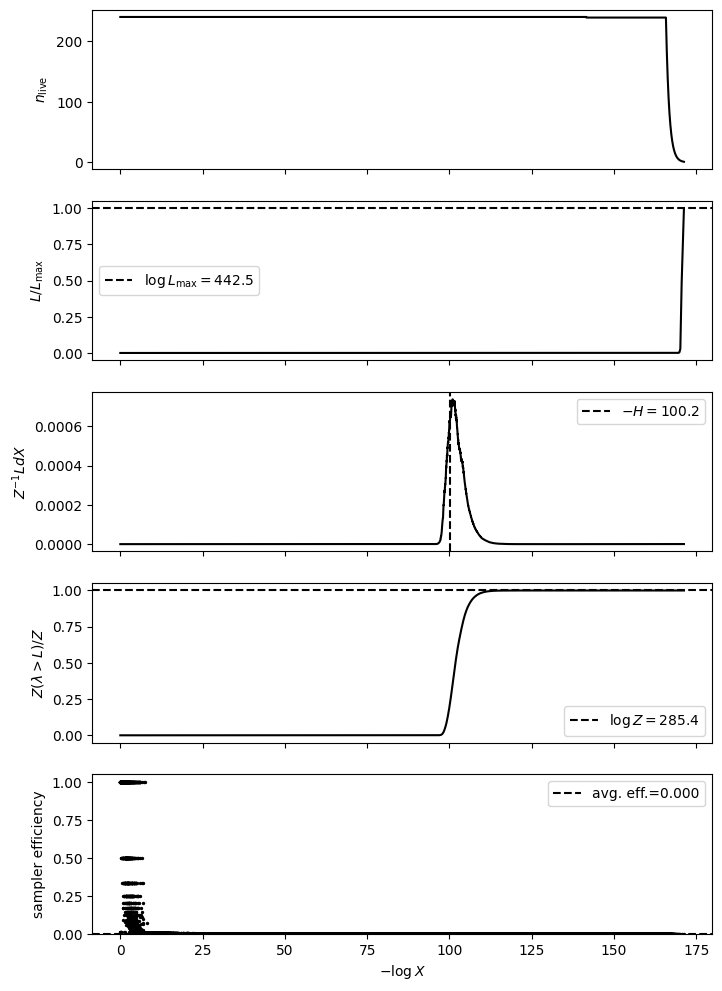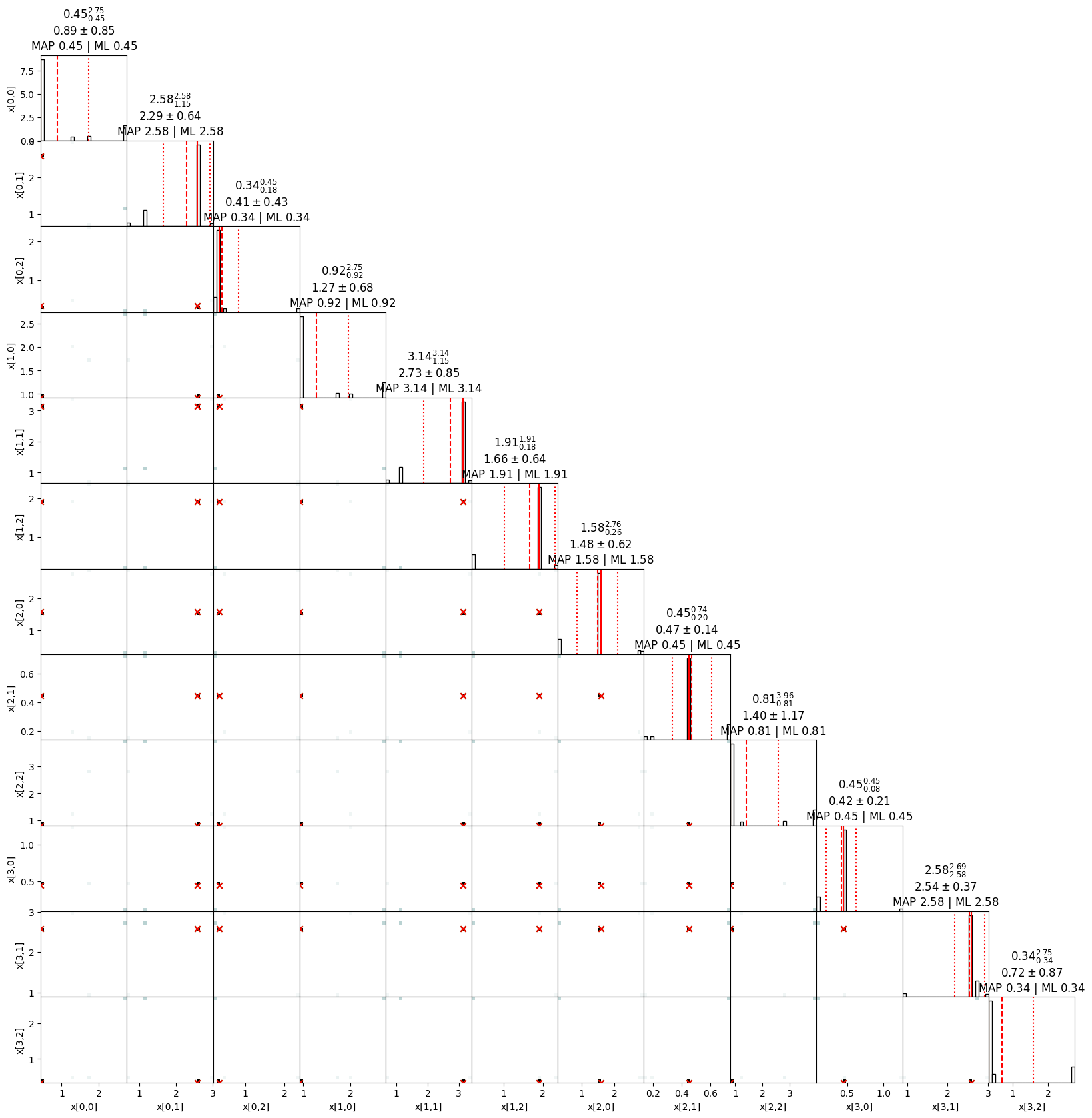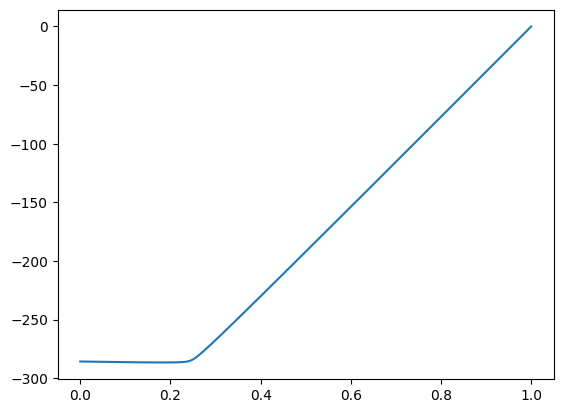Lennard-Jones Potentials for modelling phase transitions in materials
Nested Sampling is the ideal tool for computing the partition function.
where \(\beta \in [0, \infty)\) is the inverse temperature parameter, \(\mathcal{X}\) is the set of all configurations of the system, and \(E : \mathcal{X} \to \mathbb{R}\) is the potential function, which in this case will be the Lennard-Jones potential,
In this equation, the \(-\epsilon\) represents the energy of the ground state, and \(\sigma\) is the equilibrium distance when the potential energy is zero.
The system is invariant to changes in sigma and the total size of the region. Therefore, we choose \(\sigma\) as a ratio with the size of the box. We’ll chose to sample states within a unit box, therefore, we are choosing how big the box is in units of \(\sigma\). Choosing \(\sigma=0.01\) is equivalent to choosing, means the volume is roughly 100 particles per side.
[24]:
from jax.config import config
# config.update("jax_enable_x64", True)
import tensorflow_probability.substrates.jax as tfp
from jax import random, numpy as jnp
from jax import vmap
from jaxns import Model
from jaxns import Prior
tfpd = tfp.distributions
[25]:
def pairwise_distances_squared(points):
n = points.shape[0]
pair_indices = jnp.triu_indices(n, 1) # Upper triangular indices, excluding diagonal
# Create function that calculates the distance between two points
def dist_fn(ij):
i, j = ij
return jnp.sum(jnp.square(points[i] - points[j]))
# Apply this function to each pair of indices
pairwise_distances = vmap(dist_fn)(pair_indices)
return pairwise_distances
def test_pairwise_distances_squared():
# Example usage
points = jnp.array([[1, 2], [3, 4], [5, 6], [7, 8]])
assert jnp.all(pairwise_distances_squared(points) == jnp.asarray([8, 32, 72, 8, 32, 8]))
[26]:
from jaxns.internals.log_semiring import LogSpace
num_particles = 4
sigma = jnp.asarray(0.439)
box_length = jnp.asarray(4.)
def log_likelihood(x):
"""
V12-6 potential for LJ.
"""
r2 = LogSpace(jnp.log(pairwise_distances_squared(x / sigma)))
r6 = r2 * r2 * r2
r12 = r6 * r6
negE = r12 ** (-1) - r6 ** (-1)
return negE.sum().log_abs_val
def prior_model():
x = yield Prior(tfpd.Uniform(low=jnp.zeros((num_particles, 3)), high=box_length * jnp.ones((num_particles, 3))),
name='x')
return x
model = Model(prior_model=prior_model,
log_likelihood=log_likelihood)
model.sanity_check(random.PRNGKey(42), 1000)
INFO[2024-01-10 01:04:29,435]: Sanity check...
INFO[2024-01-10 01:04:29,461]: Sanity check passed
[27]:
import jax
from jaxns import DefaultNestedSampler
# Create the nested sampler class. In this case without any tuning.
ns = DefaultNestedSampler(
model=model,
max_samples=1e6,
s=model.U_ndims*1,
k=0,
c=model.U_ndims*20
)
ns_compiled = jax.jit(ns).lower(jax.random.PRNGKey(42)).compile()
termination_reason, state = ns_compiled(random.PRNGKey(42))
results = ns.to_results(
termination_reason=termination_reason,
state=state,
trim=True
)
[28]:
from jaxns import summary
# We can use the summary utility to display results
summary(results)
--------
Termination Conditions:
Small remaining evidence
--------
likelihood evals: 211192171
samples: 40080
phantom samples: 0
likelihood evals / sample: 5269.3
phantom fraction (%): 0.0%
--------
logZ=285.44 +- 0.64
H=-100.15
ESS=683
--------
x[#]: mean +- std.dev. | 10%ile / 50%ile / 90%ile | MAP est. | max(L) est.
x[0]: 0.92 +- 0.88 | 0.45 / 0.45 / 2.75 | 0.45 | 0.45
x[1]: 2.27 +- 0.65 | 1.15 / 2.58 / 2.58 | 2.58 | 2.58
x[2]: 0.4 +- 0.42 | 0.18 / 0.34 / 0.34 | 0.34 | 0.34
x[3]: 1.3 +- 0.7 | 0.92 / 0.92 / 2.75 | 0.92 | 0.92
x[4]: 2.7 +- 0.87 | 1.15 / 3.14 / 3.14 | 3.14 | 3.14
x[5]: 1.63 +- 0.67 | 0.18 / 1.91 / 1.91 | 1.91 | 1.91
x[6]: 1.45 +- 0.63 | 0.26 / 1.58 / 1.58 | 1.58 | 1.58
x[7]: 0.48 +- 0.14 | 0.45 / 0.45 / 0.74 | 0.45 | 0.45
x[8]: 1.5 +- 1.2 | 0.8 / 0.8 / 4.0 | 0.8 | 0.8
x[9]: 0.41 +- 0.21 | 0.08 / 0.45 / 0.45 | 0.45 | 0.45
x[10]: 2.54 +- 0.36 | 2.58 / 2.58 / 2.69 | 2.58 | 2.58
x[11]: 0.76 +- 0.91 | 0.34 / 0.34 / 2.75 | 0.34 | 0.34
--------
[29]:
from jaxns import plot_diagnostics, plot_cornerplot
# We plot useful diagnostics and a distribution cornerplot
plot_diagnostics(results)
plot_cornerplot(results)


[37]:
from jax import jit
@jit
def compute_partition(beta):
# int dp(x) exp(beta E(x))
dp = LogSpace(results.log_dp_mean)/LogSpace(results.log_L_samples)
exp_beta_negE = LogSpace(beta * results.log_L_samples)
return (dp * exp_beta_negE).sum().log_abs_val
x = []
y = []
for beta in jnp.linspace(0, 1, 2000):
Z_beta = compute_partition(beta)
x.append(beta)
y.append(Z_beta)
import pylab as plt
plt.plot(x, y)
plt.show()

[30]: